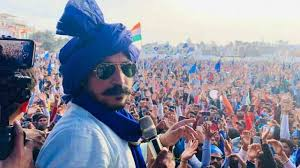Abhay Kumar

If Lalu Prasad Yadav-led RJD’s candidate Sarfaraz Alam wins from the Araria parliamentary seat (Bihar), the constituency would become a “den of ISI”, Pakistan intelligence agency. This is what Bihar State BJP president Nityanand Rai recently said during the poll campaign for the 2018 Araria byelection, which had fallen vacant after the demise of Alam’s father and RJD MP Mohd Taslimuddin. Rightly, his venomous remarks–aimed at creating hatred among religious groups and dividing voters along the sharp religious lines on the eve of elections–drew wider condemnation but one should not think that the BJP Bihar president spat venom accidentally. In this piece, I will try to argue that stigmatising and demonising a locality with sizable Muslim population—is an old narrative of the Hindutva forces. Sixty-two years before the Bihar state BJP’s remark, Madhav Sadashiv Golwalkar (1906-1973), the second Sarsanghchalak (supreme leader) of the RSS, equated Muslim locality with “miniature” [mini] Pakistan.
One can see here Golwalkar’s “miniature Pakistan” and Ujiyarpur Member of Parliament Nityanand Rai’s “den of ISI” remarks share many similarities. Let me quote Rai: “If RJD candidate Sarfaraz wins, Araria will become a den of the ISI. If Pradip Singh [BJP’s candidate] wins, it will remain a place of patriots (Indian Express, March 12, 2018)”.
What Rai tried to depict was that Hindus and Hindu candidates who are contesting on the BJP platform, are patriots and their election would bring peace and security. Contrary to this, Muslims, as he implied, were at least less patriotic than Hindus and their election to Parliament would joepardise national security. More worrying is his attempt to equate Muslims with Pakistan.
As would be evident here, Golwalkar (Bunch of Thoughts: 1966) made a similar remark. Almost six decades back. Golwalkar expressed deep “concern” about “countless miniature Pakistans” in our country. Such miniature [or mini] Pakistans, as he feared, were “internal threats” posing “far greater menace to national security” than “aggressors from outside”. Rai similarly invoked the ghost of ISI, if the RJD (Muslim) candidate was elected to Parliament.
A little later, Golwalkar himself felt “alarmed” about the existence of such mini Pakistans: “within the country there are so many Muslim pockets, i.e.; so many ‘miniature Pakistans’, where the general law of the land is to be enforced only with certain modifications and the whims of the miscreants have to be given the final say (p. 175).” The criminals are found in every social group and they are in every social group but Golwalkar believed that the criminals are mostly produced in Muslim localities.
The ideologue of Hindutva forces, Golwalkar went on spitting venom and “lamented” that Muslims everywhere were working as “agents” of Pakistan. He concluded his chapter on Muslims in these words, “in practically every place, there are Muslims who are in constant touch with Pakistan over the transmitter enjoying not only the rights of an average citizen but also some extra privileges and extra favour because they are minorities (p. 176)!’ Rai’s den of ISI-remark, as it is evident here, is nothing but a re-articulation of Golwalkar’s views.
This communal discourse has created “fear” among a section of non-Muslims about the Muslims and Muslim locality. Even the police and administration, which are duty-bound to follow secular values, consider Muslims as “posing threat to security” and perceive the Muslim localities as “negative” zones. As a result, the Muslim localities face all kinds of discrimination at the hands of the government, the police, and the administration. The media, too, contributes to the durability of such a discourse.
Those who may think my formulation is exaggerated should visit Muslim localities. Most of such areas do not have basic facilities. When I say most of the Muslim localities lack facilities, I do not mean that non-Muslim localities, particularly those where Dalits and other marginalized groups are living, have all the facilities. What I am trying to do is to underscore the particular stigma and threat-perception attached to Muslim localities.
The moment one enters a Muslim locality, one may observe this stark difference: the lack of open spaces, the presence of relatively less number of banks, ATMs, schools, hospitals, the irregular supply of electricity and water etc. In contrast to all these, the presence of police would be everywhere. Too many barricades and barracks would be found in place. Even the Prime-Minister constituted Sachar Committee report pointed to this grim reality “that police presence in Muslim localities is more common than the presence of schools, industry, public hospitals, and banks”.
This durable communal discourse “empowers” and gives impunity to the police, the army, and other security forces to storm into any Muslim house and pick up any suspect and do whatever they like. In most of the cases, human rights are brazenly violated and the innocent Muslims are denied justice. But the high-handedness of police and security forces does not get questioned for the fear that their “morale” may “go down”. The impunity enjoyed by them goes on, irrespective of the nature of the political party in power. The governments come and go but the perception hardly gets changed. Even the secular-Congress-ruled government, many would argue, saw framing of hundreds of innocent Muslim youths in the name of curbing terror and maintaining peace. One can see here, I would argue, the massive impact of the “mini” Pakistan discourse.
This communal discourse casts its shadow elsewhere as well. Let me give the example of India-Pakistan cricket match. During my childhood days, when India lost to Pakistan, many friends would say, drawing our attention to any distant noise that the Muslims areas were “celebrating” Pakistan’s victory by exploding firecrackers. I do not think that much has changed and we often get to hear such remarks during the India-Pakistan cricket match. Such a discourse is durable because political leaders like Rai articulate it on an everyday basis. An overwhelming section of our national media has never questioned such a discourse. As a result, the Muslim locality remains on the radar of the police and intelligence agencies.
In my personal experience, I, too, have felt the impact of Golwalkar’s discourse. Dhaka (not to be confused with Bangladesh’s capital) is a small town in my home district East Champaran in Bihar, where Muslims have a large population. In my childhood days, I often heard some people call Dhaka as “mini Pakistan”. During my graduation days in Patna, I used to stay in Sabzi Bagh, which has a considerable Muslim population. On several occasions when I told my friends that I lived in Sabzi Bagh, they would feel shocked and would ask me, “How could you live there?” Unlike what they perceived, I enjoyed every moment of my four-year stay there.
As political commentators have rightly argued, attaching stigma and creating fear about the Muslim localities help the Hindutva forces forge a communal majority in elections. They know very well that they can only remain in power (and impose their anti-people policies) if they keep people divided on religious lines. The discourse of mini Pakistan and den of ISI helps the Hindutva forces succeed in their design. Also related to this is the discourse of Bangladeshi (Muslim) migrants. When the Army Chief Gen. Bipin Rawat expressed “concern” about the phenomenal growth of Muslim population in the border state of Assam, he was re-articulating Golwalkar’s position. When Hindutva forces take out the so-called tirangayatra--but they carry RSS flags—and pass through the Muslim localities and raise “anti-Pakistan” slogans, they do nothing but operate within Golwalkar’s discourse.
Creating and sustaining such a discourse has an economic dimension as well. The stigmatized Muslim locality, deprived of basic amenities, is often the only shelter for the poorest of the poor Muslims, who are otherwise denied the space elsewhere. The “mini” Pakistan discourse is often employed to create the cheapest labour in the city and facilitate maximum surplus extraction.
~~~
Abhay Kumar is pursuing PhD at Centre for Historical Studies, Jawaharlal Nehru University, New Delhi. You may read his other writings at abhaykumar.org










